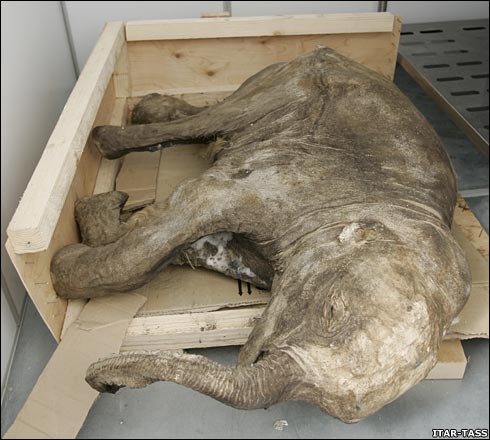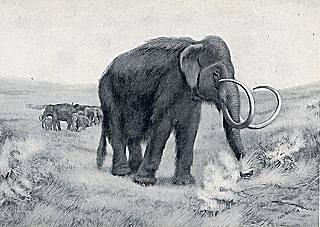
July 10, 2007

Fifty years ago, Bernard Heuvelmans collected and published reports of modern sightings of supposedly extinct mammoths seen alive today, in the boreal forests of Siberia. Thoughts that mammoths had survived probably stemmed from finds of extremely fresh specimens thawing out of the tundra’s permafrost.
Two questions, one cryptozoological and the other Fortean, nevertheless, are raised whenever there is new talk of such discoveries:
(1) Did these mammoths live during contemporary times with modern humans, as discussed by Heuvelmans and others?
(2) Were they frozen in a quick “flash freeze” incident, as first noted by Ivan T. Sanderson? In Sanderson’s 1960 Saturday Evening Post article, “Riddle of the Frozen Giants,” he wrote of his catastrophic astronomical theory to explain the frozen mammoths and frozen wooly rhinos. You will find that Sanderson’s claims were debunked because, among other items, mammoths were said to have rotten before they froze. Out of disfavor today, will future climatic studies find evidence for such events, in terms of Sanderson’s theory? Are new findings that the rotting happened as the permafrost was thawing and before the discoveries were made, assist with bringing Sanderson’s notions about frozen Pleistocene megafauna, into new critical review? And what can we learn from this new 2007 discovery?

An archival drawing of a mammoth.
Breaking news now comes of not a “decaying frozen mammoth” rotting in the tundra’s permafrost and being eaten by dogs, but of a baby, (see photo at top) said to be the “best preserved specimen of its type.”
The BBC News has published the following, which I have edited to remove the general background information on mammoths (available with the original article, see url below):
A baby mammoth unearthed in the permafrost of north-west Siberia could be the best preserved specimen of its type, scientists have said. The frozen carcass is to be sent to Japan for detailed study.
The six-month-old female calf was discovered on the Yamal peninsula of Russia and is thought to have died 10,000 years ago. The animal’s trunk and eyes are still intact and some of its fur remains on the body. In terms of its state of preservation, this is the world’s most valuable discovery.
* * *
The 130cm (4ft 3ins) tall, 50kg Siberian specimen dates to the end of the last Ice Age, when the great beasts were vanishing from the planet. It was discovered by a reindeer herder in May this year. Yuri Khudi stumbled across the carcass near the Yuribei River, in Russia’s Yamal-Nenets autonomous district.
Last week, an international delegation of experts convened in the town of Salekhard, near the discovery site, to carry out a preliminary examination of the animal.
“The mammoth has no defects except that its tail was bit off,” said Alexei Tikhonov, vice director of the Zoological Institute of the Russian Academy of Sciences and a member of the delegation. “In terms of its state of preservation, this is the world’s most valuable discovery,” he said.
Larry Agenbroad, director of the Mammoth Site of Hot Springs research centre in South Dakota, US, said: “To find a juvenile mammoth in any condition is extremely rare.” Dr Agenbroad added that he knew of only three other examples.
Some scientists hold out hope that well preserved sperm or other cells containing viable DNA could be used to resurrect the mammoth.
Despite the inherent difficulties, Dr Agenbroad remains optimistic about the potential for cloning.
“When we got the Jarkov mammoth [found frozen in Taimyr, Siberia, in 1997], the geneticists told me: ‘if you can get us good DNA, we’ll have a baby mammoth for you in 22 months’,” he told BBC News. That specimen failed to yield DNA of sufficient quality, but some researchers believe it may only be a matter of time until the right find emerges from Siberia.
* * * 8
Dr Agenbroad warned that scientifically valuable Siberian mammoth specimens were being lost to a lucrative trade in ivory, skin, hair and other body parts. The city of Yakutsk in Russia’s far east forms the hub for this trade. Local people are scouring the Siberian permafrost for remains to sell on, and, according to Dr Agenbroad, more carcasses could be falling into the hands of dealers than are finding their way to scientists.
“These products are primarily for collectors and it is usually illicit,” he explained. “Originally it was for ivory, now it is everything. You can now go on almost any fossil marketing website and find mammoth hair for $50 an inch. It has grown beyond anyone’s imagination.” Dr Agenbroad added: “Russia says that any mammoth remains are the property of the Russian government, but nobody really pays attention to that.”
The Yamal mammoth is expected to be transferred to Jikei University in Tokyo, Japan, later this year. A team led by Professor Naoki Suzuki will carry out an extensive study of the carcass, including CT scans of its internal organs.
Mammoths first appeared in the Pliocene Epoch, 4.8 million years ago. What caused their widespread disappearance at the end of the last Ice Age remains unclear; but climate change, overkill by human hunters, or a combination of both could have been to blame. One population of mammoths lived on in isolation on Russia’s remote Wrangel Island until about 5,000 years ago.-by Paul Rincon, Science reporter, BBC News “Baby mammoth discovery unveiled,”
Tuesday, 10 July 2007.
About Loren Coleman
Loren Coleman is one of the world’s leading cryptozoologists, some say “the” leading living cryptozoologist. Certainly, he is acknowledged as the current living American researcher and writer who has most popularized cryptozoology in the late 20th and early 21st centuries.
Starting his fieldwork and investigations in 1960, after traveling and trekking extensively in pursuit of cryptozoological mysteries, Coleman began writing to share his experiences in 1969. An honorary member of Ivan T. Sanderson’s Society for the Investigation of the Unexplained in the 1970s, Coleman has been bestowed with similar honorary memberships of the North Idaho College Cryptozoology Club in 1983, and in subsequent years, that of the British Columbia Scientific Cryptozoology Club, CryptoSafari International, and other international organizations. He was also a Life Member and Benefactor of the International Society of Cryptozoology (now-defunct).
Loren Coleman’s daily blog, as a member of the Cryptomundo Team, served as an ongoing avenue of communication for the ever-growing body of cryptozoo news from 2005 through 2013. He returned as an infrequent contributor beginning Halloween week of 2015.
Coleman is the founder in 2003, and current director of the International Cryptozoology Museum in Portland, Maine.
Filed under Artifacts, Breaking News, Cryptomundo Exclusive, Cryptotourism, CryptoZoo News, Cryptozoologists, Cryptozoology, Extinct, Fossil Finds, Museums